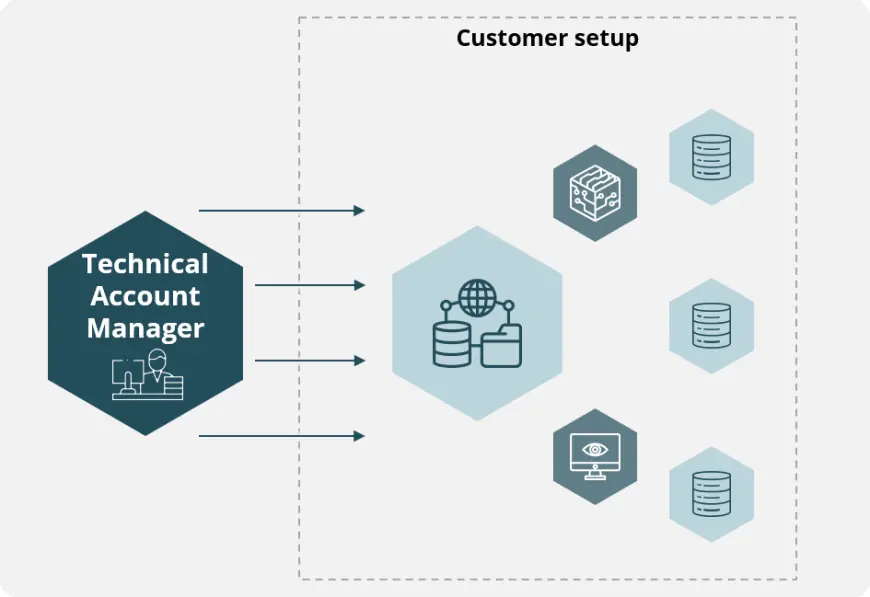Understanding the Role of a Technical Account Manager (TAM) and the Role of Account Management Software
In this article, we will explore the responsibilities and benefits of the Technical Account Manager role, as well as the role of Account Management Software in supporting these professionals and improving customer experience.

In today’s dynamic business environment, managing customer relationships, optimizing service delivery, and ensuring high levels of customer satisfaction are crucial components for the success of any organization. This has led to the growing importance of roles like the Technical Account Manager (TAM), who is responsible for maintaining and enhancing these relationships. Moreover, the use of specialized tools such as Account Management Software is becoming essential in helping organizations streamline and scale their customer management processes.
In this article, we will explore the responsibilities and benefits of the Technical Account Manager role, as well as the role of Account Management Software in supporting these professionals and improving customer experience.
The Role of a Technical Account Manager (TAM)
A Technical Account Manager (TAM) is a specialized role that combines technical expertise with customer service skills. TAMs are primarily responsible for managing the relationship between a company and its clients, ensuring that the customer’s technical needs are met, and acting as the primary point of contact for any issues that require technical resolution. The TAM role is commonly found in industries such as IT services, SaaS (Software as a Service), cloud computing, and other technology-driven sectors.
Key Responsibilities of a TAM
Customer Onboarding and Integration: One of the key responsibilities of a TAM is to ensure that customers are smoothly onboarded and integrated into the company's systems or platforms. This includes working closely with technical teams to ensure that the product or service is properly implemented and configured according to the customer's needs.
Relationship Management: A TAM is responsible for building and maintaining long-term relationships with customers. By understanding the customer's business goals and challenges, TAMs can provide personalized guidance, suggestions, and solutions that align with the client's needs.
Technical Support and Troubleshooting: A TAM serves as the primary point of contact for any technical issues that arise during the lifecycle of the customer’s engagement with the company. This involves troubleshooting problems, working with internal engineering teams, and ensuring that issues are resolved in a timely and effective manner.
Product Customization and Optimization: TAMs work to ensure that the customer gets the most out of the company's products or services. This could involve recommending product upgrades, customizations, or adjustments to meet the evolving needs of the customer. TAMs also monitor the product’s performance to ensure it aligns with the client’s expectations.
Advocating for the Customer: TAMs serve as the voice of the customer within the organization. They communicate feedback, concerns, and requests to the product development teams to help improve the product. This advocacy ensures that the customer's requirements are met, not only during implementation but throughout the entire relationship.
Training and Education: To help customers fully leverage the product, TAMs often provide ongoing training and resources. This ensures that customers can use the product efficiently, which can result in greater customer satisfaction and retention.
Upselling and Renewals: While TAMs are not typically part of the direct sales team, they play a role in identifying opportunities for upselling, cross-selling, and renewing contracts. By understanding the customer's needs and offering solutions, TAMs can help expand the business relationship.
Monitoring Customer Health and Success: A key component of the TAM’s role is to monitor customer satisfaction and health. This involves tracking customer engagement, reviewing product usage metrics, and identifying any red flags or warning signs of potential dissatisfaction or churn.
Skills and Qualities of a Successful TAM
A successful TAM possesses a unique combination of technical knowledge, communication skills, and customer service expertise. Some of the key qualities of a good TAM include:
Strong Technical Expertise: Given that TAMs deal with technical products and services, they need to have a deep understanding of the company's offerings and the technology behind them. This enables them to troubleshoot issues and suggest technical solutions effectively.
Excellent Communication Skills: TAMs need to interact with clients regularly. Clear, concise, and empathetic communication is crucial for resolving issues, explaining technical concepts, and building trust.
Problem-Solving Skills: TAMs are often called upon to resolve complex technical issues. They need to be creative and resourceful in identifying solutions that meet the client’s needs and keep the relationship on track.
Customer-Centric Mindset: The core of the TAM role is ensuring the customer’s success. TAMs must genuinely care about their customers' satisfaction and work towards building a positive, long-term relationship.
Project Management Skills: Often dealing with multiple clients and projects simultaneously, TAMs need to manage their time and resources efficiently. Strong organizational and multitasking skills are important for delivering high-quality service.
How Account Management Software Supports TAMs
As the role of the TAM becomes increasingly complex, relying on traditional tools like spreadsheets and email becomes less efficient. To manage customer relationships effectively, many organizations are turning to Account Management Software (AMS), which provides a range of tools designed to streamline the process of managing customer accounts and interactions.
Key Features of Account Management Software
Centralized Customer Data: AMS tools provide a centralized platform for storing and managing customer information. This includes everything from contact details to purchase history and interaction logs. By having all customer information in one place, TAMs can provide a more personalized experience and quickly access important details.
Task and Workflow Automation: Many AMS solutions offer automation features that allow TAMs to automate routine tasks like sending follow-up emails, scheduling meetings, or setting reminders for renewal dates. This helps TAMs stay organized and frees up time to focus on more strategic activities.
Customer Health Monitoring: AMS tools often include features that monitor the health of customer relationships. Metrics like product usage, support ticket volume, and customer satisfaction scores can help TAMs identify potential issues early and take proactive steps to address them.
Collaboration Features: AMS tools make it easier for TAMs to collaborate with other departments, such as sales, engineering, and product management. By having shared visibility into the customer’s account, teams can work together to resolve issues or identify opportunities for growth.
Reporting and Analytics: Detailed reporting features within AMS tools allow TAMs to track key performance indicators (KPIs) like customer retention, revenue growth, and satisfaction scores. These insights help TAMs make data-driven decisions and improve the overall customer experience.
Customer Communication Management: Effective communication is central to the TAM role, and AMS tools provide a variety of communication features, including email tracking, messaging, and integration with other communication platforms. This ensures that TAMs can keep customers informed and maintain regular contact.
Benefits of Using Account Management Software for TAMs
Increased Efficiency: By centralizing customer data and automating routine tasks, AMS tools enable TAMs to work more efficiently, improving their ability to manage multiple accounts simultaneously.
Improved Customer Experience: With better visibility into customer interactions and more personalized communication, TAMs can deliver a superior customer experience, leading to higher customer satisfaction and loyalty.
Proactive Account Management: The ability to monitor customer health in real-time helps TAMs identify potential issues before they escalate. This proactive approach can reduce churn and improve retention rates.
Scalability: As a company grows and acquires more customers, AMS tools help scale customer account management processes. This allows TAMs to handle a larger number of accounts without compromising on service quality.
Better Collaboration Across Teams: Account Management Software ensures that all teams involved in customer success, such as support, product, and sales, are aligned and working together towards the same goal of improving the customer experience.
Conclusion
The role of a Technical Account Manager (TAM) is vital for ensuring the success and satisfaction of customers in today’s technology-driven industries. TAMs bridge the gap between technical solutions and customer needs, managing complex relationships and ensuring that customers get the most out of their products or services.
However, as customer expectations and business demands increase, the role of the TAM becomes more challenging. This is where Account Management Software comes in. By streamlining communication, automating tasks, and providing data-driven insights, AMS tools help TAMs manage accounts more efficiently, ensuring a seamless customer experience.
In conclusion, the combination of a skilled TAM and the right software tools is a winning formula for driving customer success, improving retention, and fostering long-term business growth.
What's Your Reaction?
 Like
0
Like
0
 Dislike
0
Dislike
0
 Love
0
Love
0
 Funny
0
Funny
0
 Angry
0
Angry
0
 Sad
0
Sad
0
 Wow
0
Wow
0
















































